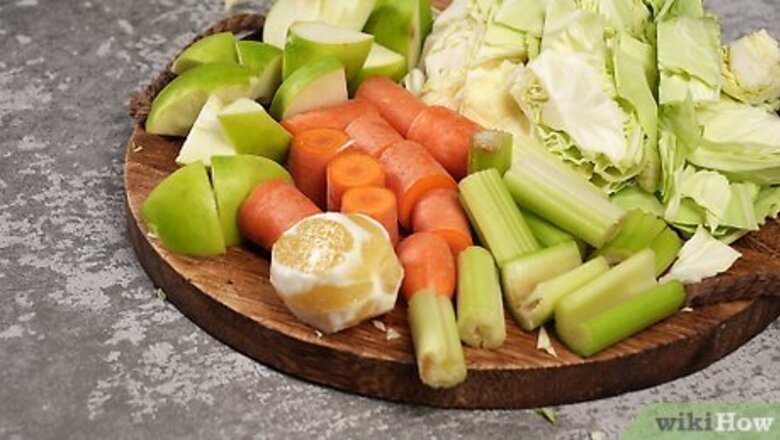
views
X
Trustworthy Source
Cleveland Clinic
Educational website from one of the world's leading hospitals
Go to source
If you’re dealing with stomach ulcers, drinking cabbage juice can also protect your stomach lining and help heal these sores.[2]
X
Trustworthy Source
PubMed Central
Journal archive from the U.S. National Institutes of Health
Go to source
In this article, we’ll show you how to make several different cabbage juice recipes so you can reap all of the benefits of this superfood!
Cabbage Juice for Ulcers
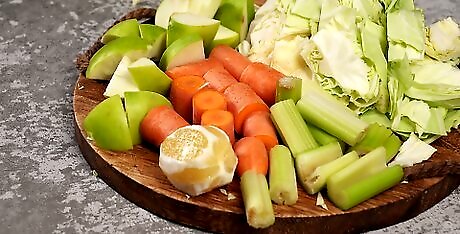
Rinse and cut the cabbage, celery, carrots, apple, and lemon. Wash your vegetables and fruit thoroughly under cool water to ensure they’re dirt-free. Then, roughly chop 1 head of cabbage, 4 to 6 stalks of celery, and 4 carrots into 1-inch (2.5 cm) chunks. Cut and core your apple and then remove the peel from your lemon. Like cabbage, celery helps heal ulcers and protect your stomach lining. It is also full of nutrients like fiber, vitamins K, A, and C, calcium, and iron. Carrots help protect against and heal ulcers, too. They also help lower cholesterol, improve your eye-sight, and are full of calcium, potassium, and vitamin A. Cabbage, celery, and carrots are all low in calories, which also makes this tasty, ulcer-fighting juice great for weight loss. The apple is mainly used to add sweetness, so choose your favorite variety. Or, feel free to not add it at all.
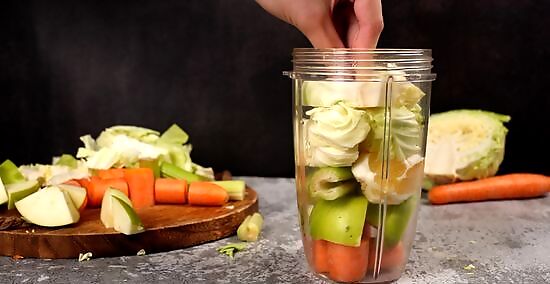
Blend the ingredients for 1-2 minutes in a blender or juicer. If you’re using a blender, add the cut cabbage, celery, carrots, apple, and lemon into your blender with a dash of water. Then, blend the ingredients for 1 to 2 minutes, or until they’re smooth and pureed together. If you’re using a juicer, just press each ingredient into your machine. If your mixture is thick and chunky, add more water to the blender until it is smooth.
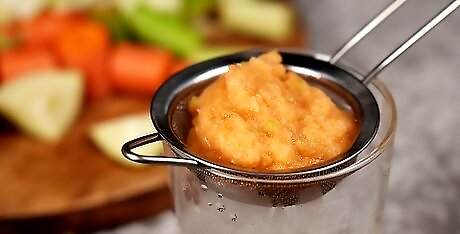
Filter the mixture through a mesh bag if you’re using a blender. Separate the fruit and vegetable pulp from the juice by pouring the mixture into a milk nut bag or fine mesh bag. Then, squeeze the contents over your cup, bottle, or container. If you like more of a smoothie texture, leave the pulp with the juice. Fruit and vegetable pulp is full of fiber, which is beneficial for your digestion and health. Compost the leftover pulp if you don’t want to use it, or simply throw it away.
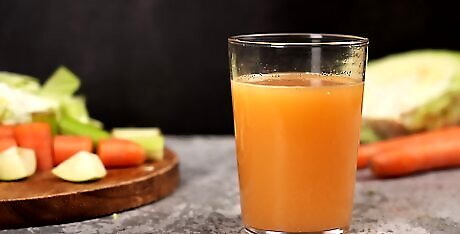
Drink your juice as soon as it’s done. For the greatest health benefits, drink your juice as soon as you make it. Leaving your juice to sit can decrease the amount of beneficial enzymes and antioxidants in your drink. Plus, bacteria tends to grow quickly on freshly juiced veggies and fruit because they lack preservatives. Alternatively, pour your juice into an air-tight bottle and store it in the fridge. Just make sure to drink it within 1 to 3 days. If you’re making cabbage juice to help heal ulcers, drink an 8 oz. (237 ml) cup 1 to 4 times each day. Some studies show that drinking cabbage juice daily can heal ulcers in around 9 days.
Basic Cabbage Juice Recipe
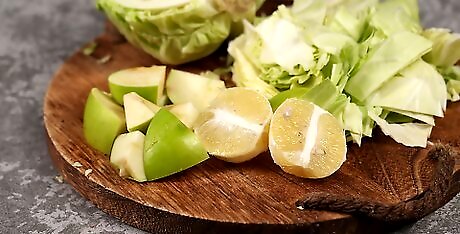
Wash and roughly chop the apple, lemon, and ½ of the cabbage. Rinse the produce under cool water to wash off any dirt and debris. Then, core the green apple and cut it into quarters. Cut the peel off the lemon and cut it into quarters, too. Finally, remove the outer leaves on your cabbage, cut it in half, and slice 1 of the halves into quarters.
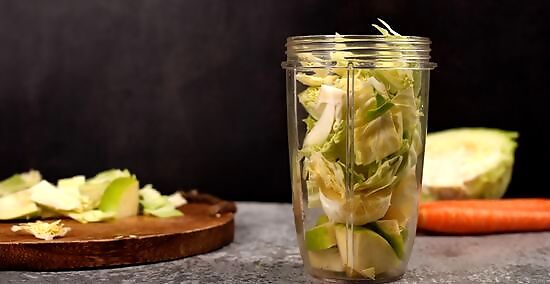
Add the apple, lemon, and cabbage to a juicer or blender. The easiest way to make cabbage juice is to put all of your cut ingredients into a juicer and let your machine do all the work. If you don’t have a juicer, a blender is a great alternative that requires just a few extra steps to make a smooth, tasty juice.
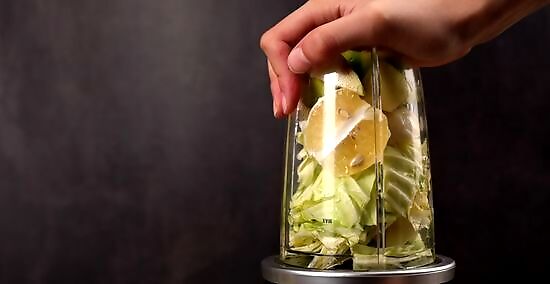
Blend the ingredients for 1-2 minutes. If you’re using a blender, add a splash of water into the container and then puree the ingredients on low for 1 to 2 minutes. Then, turn the blender on high for 10 seconds. If you’re using a juicer, simply add and juice the ingredients according to your machine’s instructions. If your mixture is super thick and not blending well, keep adding more splashes of water into the blender until the ingredients combine together smoothly.
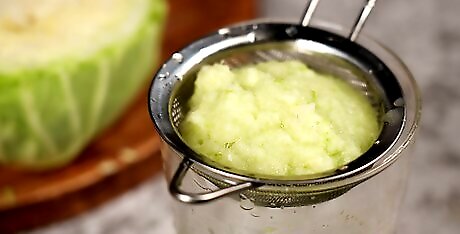
Strain the ingredients through a milk nut bag if using a blender. To extract the juice from the blended cabbage, apple, and lemon pulp, pour the mixture inside a milk nut bag, fine mesh bag, or mesh sieve. Then, hold the bag over your cup or container and squeeze it to separate the juice from the pulp.
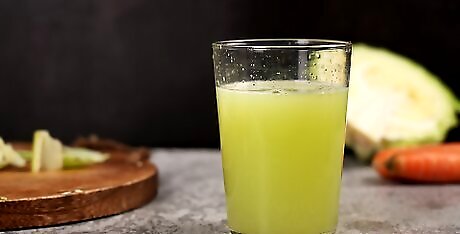
Drink and enjoy your juice. Pour your bright green juice into your cup and enjoy the refreshing, zippy flavor. Or, set it in the fridge for a few minutes to cool it off. If you have a lot of leftover juice, store it inside an airtight container or bottle in your refrigerator for 1 to 2 days.
Fruity Cabbage Juice
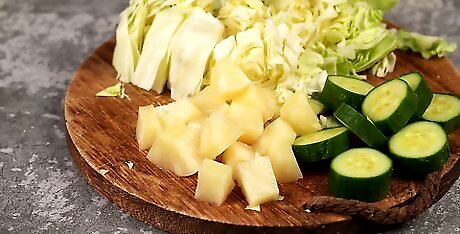
Wash and cut the cabbage, cucumber, and pineapple into pieces. Rinse the cabbage and cucumber under running water to remove any dirt. Then, chop the cabbage and ½ of the cucumber into rough, 1-inch (2.5 cm) sized pieces. Cut your pineapple into quarters and chop 1 of the quarters into 1 inch (2.5 cm) chunks. This fruity cabbage juice is completely customizable to your preferences. Simply swap out the cucumber and pineapple with another veggie or fruit you like better! For instance, try a cabbage, carrot, and orange blend. Or, mix cabbage with beetroot and apple. Add herbs and spices to boost the flavor of your juice, too. For instance, blend in ginger, mint, or parsley.
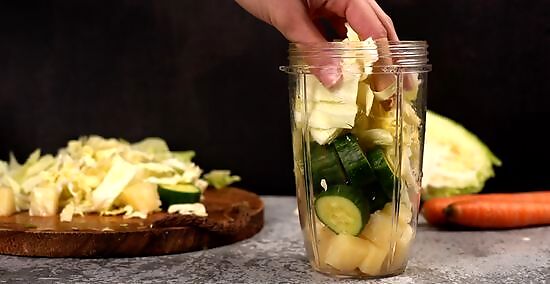
Place the ingredients in the blender or juicer and add the lemon. Add the cut cabbage, cucumber, and pineapple into your machine of choice. Then, squeeze in 1 tsp (5 ml) of lemon juice. If you want some extra sweetness, drop in 1 tbsp (12.5 grams) of sugar.
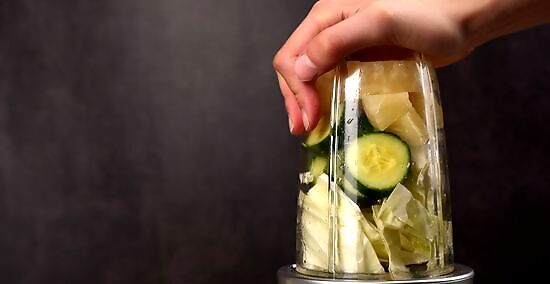
Puree the ingredients in your machine for 1-2 minutes. To mix the ingredients in your blender, add a small dash of water and blend them until they’re smooth, which takes around 1 to 2 minutes. If you’re using a juicer, add the fruits and veggies to your machine and turn it on.
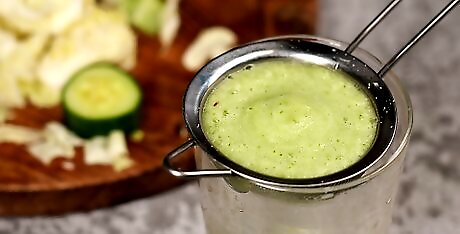
Squeeze the ingredients through a mesh bag if using a blender. To get the juice from your pureed cabbage, cucumber, and pineapple pulp, pour the mixture into a milk nut bag or mesh bag. Then, squeeze the bag over your cup or container.
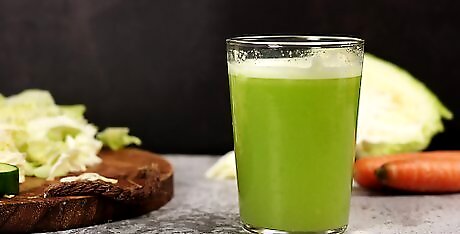
Enjoy your cup of juice as soon as you make it. Cabbage juice is best when you drink it right after you make it and before it can lose lots of beneficial enzymes, antioxidants, and other nutrients. If you can’t finish all of your juice, simply pour it into an airtight bottle or container and store it in your fridge for up to 3 days.
Fermented Cabbage Juice
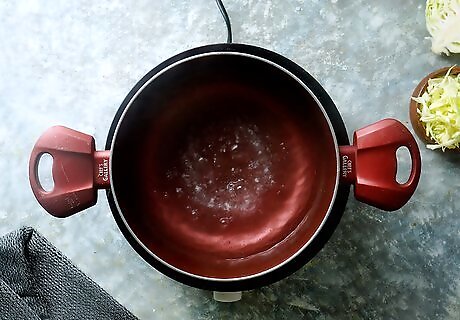
Boil 2 cups (500 ml) of water for 30 minutes, then let it cool. For the cleanest and freshest-tasting juice, boil the water on the stove for up to 30 minutes. This removes any additives in your water, like chlorine, that can affect its taste. Just pour 2 cups (500 ml) of water into a saucepan and put it over medium to high heat to boil. Then, take it off heat to cool down to room temperature. Alternatively, pour your tap water through a water filtration pitcher. Or, use distilled water. Distilled water is already processed and free from excess minerals and chemicals. Fermenting cabbage juice gives it an extra beneficial boost for your digestion, as fermentation produces probiotics.
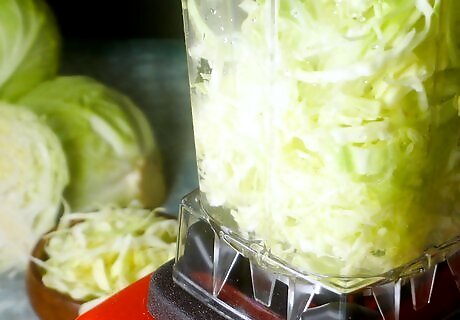
Chop the cabbage and then add it to a blender. Wash a head of green cabbage under running water and then remove the outside leaves. Then, cut the cabbage into 1-inch (2.5 cm) sized pieces until you have 3 cups (675 g) of chopped cabbage. Add the cabbage to your blender.
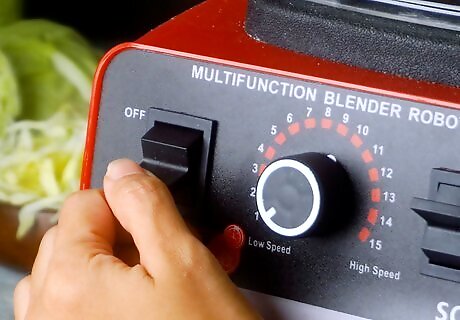
Pour in the water and blend the ingredients on low. Add the cooled, purified water into the blender, put on the blender top, and turn your blender on low speed. Just keep blending until the water is green and you see chunks of cabbage floating around, which takes about 1 to 2 minutes.
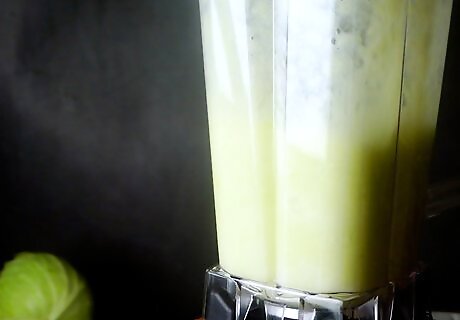
Blend the mixture on high for 10 seconds. Turn your blender on high to break up some of the chunks of cabbage. Only blend the mixture for 10 seconds so there are still a few small pieces of cabbage in the juice. You do not want to create a paste or a puree.
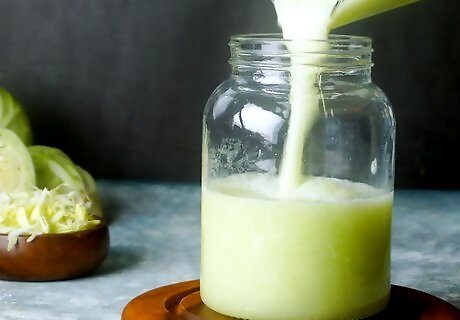
Pour the juice into a jar, leaving 1 inch (2.5 cm) between the top. Get out a bottle or container that holds at least 34 ounces (1 l) of liquid. Then, pour in your mixture, leaving about 1 inch (2.5 cm) of space between the surface of the juice and the rim of the jar. The cabbage juice expands as it ferments, so your container needs extra room to account for more liquid.
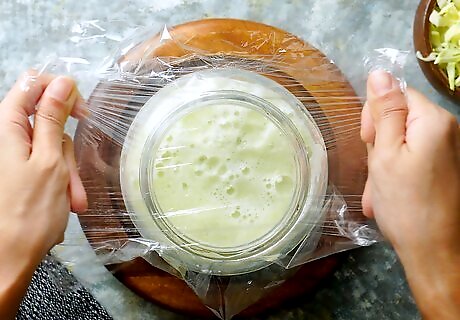
Tightly seal the jar with plastic wrap. Place a piece of plastic wrap over the top of the jar and secure it with a rubber band. If your jar has a lid, simply tighten it onto the container. For an even tighter seal, stretch plastic wrap over the jar and then screw on the cap.
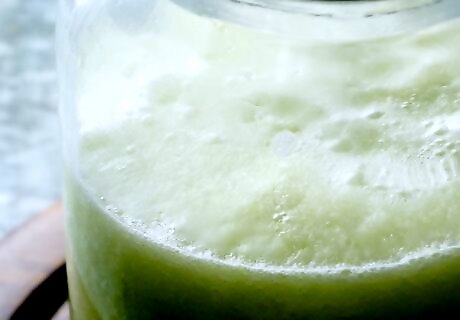
Leave the juice to sit at room temperature for 3 days. It takes several days for the cabbage to ferment and grow the beneficial probiotics and cultures that aid your digestion. Just place your jar of juice in a spot that stays at room temperature, or around 68° F (20° C), for 3 days.
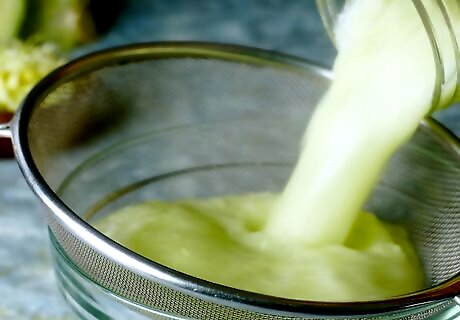
Strain the juice through a mesh sieve and into a clean jar. Place a fine mesh strainer over a clean jar that’s about the same size as the jar your juice is in. Then, pour the juice through the sieve and into the other jar. This separates the juice from the cabbage pulp.
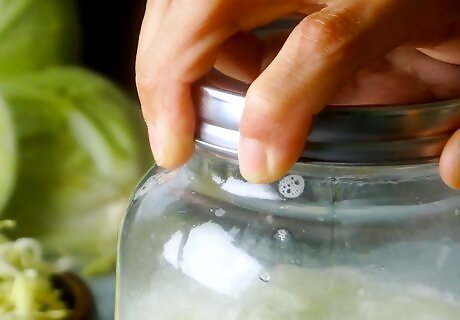
Chill the juice in the fridge, then enjoy. Fermented cabbage juice tastes best cold, so stick your jar in the fridge for a few hours. When it’s chilled, drink your refreshing juice and enjoy all its health and digestive benefits! Drink ½ cup (118 ml) of fermented cabbage juice each day, 2 to 3 times a day. Just dilute it by mixing in ½ cup (118 ml) of water before you drink it. Speed up the fermentation on your next batch of juice by adding ½ cup (118 ml) of your original batch to the water and cabbage mixture. This adds existing cultures to the mixture and means your next batch will be ready in 1 to 2 days.
















Comments
0 comment